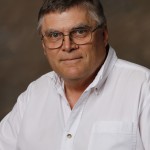By Lee J. Siegel
Four faculty members from the U are among 11 winners of the 2015 Governor’s Medal for Science and Technology. They will be honored during a Jan. 13 ceremony and dinner at Rio Tinto Stadium in Sandy.
The U honorees are Joel Harris, distinguished professor of chemistry; Rich Brown, dean of the College of Engineering; Sarah George, executive director of the Natural History Museum of Utah; and Tom Parks, vice president for research.

Joel Harris
Harris, named an awardee in the academia category, was cited as a “pioneer behind many of today’s techniques for probing molecular structure at liquid and solid interfaces.” He developed methods “that capitalize on the interaction of light with matter to reveal detailed information about molecular structure.”
During his years at the U – 2016 will be his 40th – Harris established and grew his department’s analytical chemistry program, published more than 230 peer-reviewed research papers, mentored 33 doctoral students and won numerous awards, particularly for teaching. He’s a graduate of Duke University with a doctorate from Purdue University.

Richard Brown
Brown was awarded a Governor’s Medal in the education category and was cited largely for his efforts as dean since 2004 to expand and improve the College of Engineering, its faculty and facilities; obtain Engineering Initiative funds to roughly double the number of graduates for Utah’s workforce; and develop an outreach program for thousands of K-12 students. During his tenure, his college’s research expenditures grew from $30 million to more than $80 million.
After obtaining bachelor’s and master’s degrees from BYU, Brown earned his doctorate at the U, then spent 1985-2004 at the University of Michigan before returning to Utah as dean. A major area of his research is solid-state sensors, for measuring everything from neurochemicals and heavy metals to blood glucose levels and blood gases. He also works on neural interfaces, ultimately aimed at helping people with disabilities communicate and move. His other major research field involves designing and improving integrated circuits, including better clocks to pace the operation of circuits and making circuits more efficient.
George and Parks both were awarded medals in the special recognition category.

Sarah George
A mammalogist, George was cited for raising $103 million to build the stunning, new Natural History Museum of Utah at the Rio Tinto Center, increasing annual visitors from 60,000 when she arrived at the U in 1992 to almost 300,000 now, reaching another 250,000 Utah residents in schools and through other outreach, developing interactive exhibits, establishing research programs at the museum and benefitting education at all levels statewide.
After earning bachelor’s and master’s degrees in biology at the University of Puget Sound in Tacoma and Fort Hays (Kansas) State University, George got her doctorate at the University of New Mexico and worked for eight years as a mammals curator at the Natural History Museum of Los Angeles County before taking the helm of Utah’s museum.

Tom Parks
Parks, a neuroscientist, was cited not only for his role as the U’s research vice president, but also as president of the University of Utah Research Foundation and for his leadership in earlier chairing and growing the Department of Neurobiology and Anatomy and establishing a graduate program in neuroscience and the Brain Institute, which transformed brain-imaging research in Utah. During his time as vice president, the U’s annual research budget has grown from about $306 million to $417 million. Parks also has expanded undergraduate research opportunities and has promoted the new Rio Mesa field station near Moab.
After getting a bachelor’s degree in biology at the University of California, Irvine, Parks earned a doctorate in psychobiology at Yale, and then joined the U in 1977. His research has involved spider venoms – the basis for the successful spinoff company NPS Pharmaceuticals that was sold for $5.2 billion in 2015 – and how the hearing system develops in the brain.
Lee J. Siegel is a senior science writer at University Marketing and Communications. If you have an interesting story idea, email him at lee.siegel@utah.edu.
